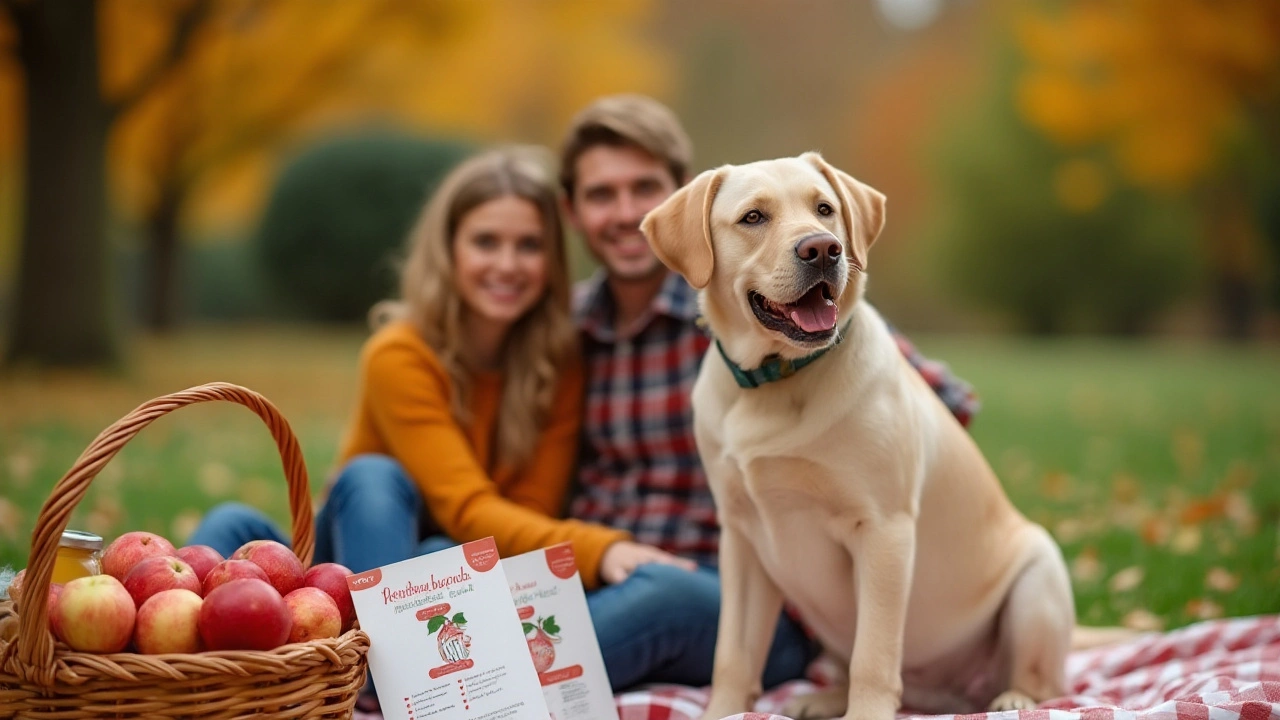Is your pup eyeing that bowl of applesauce you're about to enjoy? As a dog owner, it's natural to want to share your favorite snacks with your furry friend. Although apples are known for being a healthy treat, you might be wondering if applesauce is safe for dogs.
Let's dive into the essential details you need to consider before sharing applesauce with your dog, such as health benefits, possible risks, and how to make sure it fits peacefully into their diet.
- Nutritional Benefits of Applesauce for Dogs
- Potential Risks and Concerns
- Choosing the Right Applesauce
- Signs of Allergies and Using Applesauce in Your Dog's Diet
Nutritional Benefits of Applesauce for Dogs
When you think about sharing a tasty treat like applesauce with your dog, it's important to understand what's inside this sweet delight. Apples themselves bring a variety of health benefits to not only humans but also our furry companions. Loaded with essential vitamins such as A and C, apples contribute to maintaining your dog's skin and coat health while also supporting their immune system. The natural sweetness derived from apples comes with the bonus of dietary fiber, which aids in improving your pet's digestion and can even help in keeping your dog's weight in check when given in moderation.
It gets even better! Apples contain antioxidants, which play a role in fighting off free radicals that can cause cellular damage. This attribute could be an asset in minimizing the risks of chronic diseases. Take note, though; giving your dog applesauce needs to be more than just a casual endeavor. It's the nuanced approach that makes the essential difference, helping us focus on the health benefits while neglecting potential pitfalls.
As veterinarian Dr. Bethany White points out, "When given in moderation and without added sugars, applesauce can be a delightful, healthy addition to your dog's diet, offering a mix of vitamins and fiber."
Adding unsweetened applesauce to your dog's meals as a topper might be one way to incorporate this tasty element into their diet. A small amount added to the kibble could make the meal more enticing, especially for picky eaters. Furthermore, the fiber intake can assist dogs who may struggle with firm stools or irregular bowel movements. It's about enhancing your dog's dietary variety in a health-conscious method. However, always remember that moderation is key; too much of even a good thing can lead to undesirable effects.
In rare cases, applesauce can act as a refreshing treat, especially during hot days. Imagine freezing a few dollops of unsweetened applesauce into ice cube trays. These can transform into delightful summer-refreshing treats for your canine buddy. This simple trick not only hydrates but also cools them down effectively, all the while delivering nutritional goodness. Very much like humans, you know, dogs also appreciate a little culinary creativity occasionally! An invigorating delightful way to connect and treat them while keeping their health in mind.

Potential Risks and Concerns
When it comes to feeding your dog applesauce, it's important to understand that not all types of applesauce are created equal. Store-bought applesauce often contains added sugars and preservatives, which might be safe for humans but not for dogs. Excessive sugar can lead to obesity, dental issues, and even diabetes in dogs, making it crucial to examine the ingredients list carefully before considering it as a treat for your furry friend.
Another critical factor to consider is the potential presence of toxic additives such as xylitol, which is occasionally used as a sweetener in processed foods, including some brands of applesauce. For dogs, xylitol ingestion can result in a dramatic and potentially fatal drop in blood sugar, seizures, or even liver failure. Hence, it is undeniably important to ensure that the applesauce you're planning to share with your pet is free of such harmful components.
It is also worth considering the texture and size of apple products. The silky texture of applesauce makes it easier for dogs to digest compared to whole fruits, but serving too much at once might lead to gastrointestinal upset due to their smaller stomachs. It's crucial to introduce any new food gradually and observe your dog for any adverse reactions, such as loose stool or vomiting.
"Dogs process food differently than humans, so it's our responsibility to make sure we don't unintentionally harm them with treats we enjoy," says Dr. Maria Gonzalez, a renowned veterinarian and canine nutrition expert.
In addition, if your dog is known to have food sensitivities or allergies, applesauce could trigger an allergic reaction. Symptoms may include skin rashes, itching, or gastrointestinal distress. Apple allergies aren't exceedingly common among dogs, but they're not unheard of either. If you are introducing canine nutrition elements like applesauce for the first time, it may be wise to start with a very small amount and closely monitor your animal's response.
Feeding your pet the wrong kind of applesauce—or too much of it—can cause more harm than good. Preparing homemade applesauce eliminates unnecessary additives and gives you control over the ingredients. If you'd prefer to buy it, seek out organic brands that only list apples and water on the label, ensuring the safest choice for your canine companion. It’s all about being cautious and making informed decisions that prioritize your dog's health and well-being.

Choosing the Right Applesauce
When it comes to sharing applesauce with your dog, selecting the right type is crucial to ensuring it remains a safe and enjoyable treat. Pure, unsweetened applesauce is usually the best choice for pets because it lacks added sugars and artificial flavors that can interfere with a dog’s health. Many store-bought varieties often contain extras like high fructose corn syrup or artificial sweeteners, and some even have preservatives that might not sit well with your canine companion’s stomach. Reading labels meticulously can provide you with a lot of information about what’s inside, so it’s a step that should be taken seriously. Did you know that xylitol, an artificial sweetener found in some applesauces, is highly toxic to dogs and can lead to severe health issues if ingested?
For those who prefer a more natural route, making applesauce at home is not only simple but also ensures you know exactly what's included in your dog's treat. All it takes is apples and a blender to create a smooth puree without any hidden ingredients. Plus, making it yourself allows you to experiment with add-ins like cinnamon, which, in moderate amounts, can be beneficial for dogs due to its anti-inflammatory properties. Just be careful not to introduce harmful elements like nutmeg, which can be toxic to dogs. Homemade applesauce can also be tailored to suit the specific dietary needs of your pet, contributing to a balanced and nutritious snack.
"Always opt for organic apples if possible, to cut down on the number of pesticides and chemicals your dog is exposed to," suggests Dr. Sarah Ellis, a veterinary nutritionist.
It’s important to note the texture and form of the applesauce, too. Some dogs may prefer a smoother consistency, while others might enjoy a chunkier mash. Observing your dog's reaction to different textures can enhance their eating experience and help you understand their preferences better. This becomes especially handy if you have a picky eater on your hands. Once you've selected the perfect applesauce and taken the steps to ensure it aligns with your dog's diet, it can be integrated into their meals in a variety of ways. You could mix a spoonful into their kibble for a sweet surprise or use it as a topper for their favorite dog-friendly yogurt.
Offering applesauce as a treat fosters a stronger bond between you and your pet while providing them with a taste of something new. However, moderation is key, as applesauce should not replace a well-balanced meal but rather complement it. Remembering these points can transform a simple apple snack into a delightful treat that your dog will wag its tail for every time. By choosing wisely and keeping their health at the forefront, you can safely introduce this fruity delight into their dietary routine.

Signs of Allergies and Using Applesauce in Your Dog's Diet
When introducing applesauce into your dog's diet, it's essential to be aware of potential allergic reactions. Dogs, like humans, can have food allergies, and while rare, apples or applesauce can sometimes be the trigger. Common signs to look for include itching, swelling, or redness around the face, muzzle, or ears. Areas such as the underbelly can also become inflamed. In more severe cases, you might notice gastrointestinal symptoms like vomiting or diarrhea. It's crucial to monitor your dog after introducing any new food, including applesauce, especially if it's their first time trying it. Keeping a close eye ensures that you can quickly identify any adverse reactions and consult your veterinarian promptly.
Using applesauce in your dog's diet isn't just about avoiding allergens, though; it's also about boosting their nutrition effectively. Applesauce can be a healthy treat when given in moderation due to its fiber and vitamin C content. However, store-bought applesauce often contains added sugars or artificial flavors, which can do more harm than good. Always opt for unsweetened, organic applesauce or, better yet, make your own at home. Puree peeled apples until smooth, ensuring no seeds or cores are included. Homemade applesauce can be a treat topping over kibble or even frozen into bite-sized snacks for a refreshing delight during warm weather.
"Veterinarians generally recommend introducing new foods slowly, while keeping a list of ingredients your pet ingests to identify potential allergens," says Dr. Emily Weston from the Canine Nutrition Institute.Dr. Weston’s advice underlines the importance of a cautious approach. Begin by offering just a spoonful of applesauce and wait before increasing the amount. It’s this gentle method that ensures not only your dog’s safety but also their enjoyment of this new treat. Also, using applesauce as a reward during training can mix up the experience, providing not just a tasty incentive but also a bonding moment for you and your canine friend.
If your dog shows any negative reaction, it's vital to stop feeding them applesauce immediately and seek veterinary attention if symptoms persist. An elimination diet might be recommended to identify specific allergens if you’re unsure what's causing an issue. This method of cautious introduction isn’t just specific to applesauce; it’s a guideline that applies to any new food in a dog’s diet. Keep informed, stay observant, and your furry companion can enjoy a varied, safe culinary journey.





